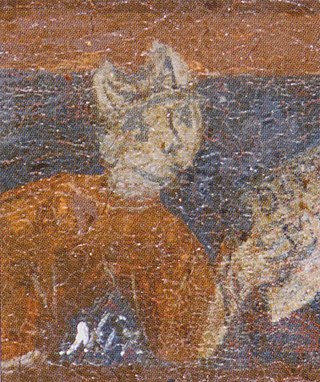Related Research Articles
Matthias from the kindred Rátót was a Hungarian prelate in the first half of the 13th century, who served as Bishop of Vác from 1238 to 1240, then Archbishop of Esztergom from 1239 until his death in the Battle of Mohi. He was the first Archbishop of Esztergom, who was referred to as Primate of Hungary.
Desiderius or Ders was a Hungarian prelate in the 11th century, who served as Archbishop of Kalocsa from around 1064 to 1076.
Kalán from the kindred Bár-Kalán was a prelate and royal official in the Kingdom of Hungary at the turn of the 12th and 13th centuries. He was bishop of Pécs from 1186 until his death in 1218, and ban of Croatia and Dalmatia between 1193 and 1194, thus he was the first prelate in the kingdom to parallelly held a secular office. Kalán's relationship with the monarch was tense in the reign of King Emeric who accused the bishop of incest but could never prove it. Although a part of the canons of Esztergom elected Kalán as archbishop in 1204, his election was not confirmed by the Holy See. Kalán died when planning to go on a crusade to the Holy Land.

John was a prelate in the Kingdom of Hungary in the 12th and 13th centuries. He was Bishop of Csanád between 1198 and 1201, Archbishop of Kalocsa from 1202 to 1205 and Archbishop of Esztergom between 1205 and 1223. He crowned Ladislaus III of Hungary, Andrew II of Hungary and Coloman of Halych king. Andrew II appointed him to govern the kingdom during his crusade between 1217 and 1218.

Nicholas was a 12th-century prelate in the Kingdom of Hungary. He was Archbishop of Esztergom between 1181 and 1183, and Bishop of Várad from 1163 to 1181.

Robert was a French-born prelate in the Kingdom of Hungary in the first decades of the 13th century. He was Archbishop of Esztergom between 1226 and 1239 and Bishop of Veszprém from 1209 till 1226. He played a decisive role in the establishment of the short-lived Diocese of Cumania. He was sharply opposed to the employment of Jews and Muslims in the administration of the royal revenues. He even put Hungary under interdict to force Andrew II of Hungary to dismiss his non-Christian officials.
Martyrius or Martirius was a Hungarian prelate in the 12th century, who served as Bishop of Veszprém from around 1127 to 1137, Bishop of Eger from 1142 to 1150, and finally Archbishop of Esztergom from 1151 until his death.

Job was a Hungarian prelate at the turn of the 12th and 13th centuries, who served as Bishop of Vác from 1181 to 1183, and as Archbishop of Esztergom from 1185 until his death.
Timothy was a prelate in the 13th century, who served as Bishop of Zagreb from 1263 until his death.
Desiderius was a prelate in the Kingdom of Hungary in the 12th and 13th centuries, who served as Bishop of Csanád between 1202 and 1228. Before that he functioned as chancellor in the royal court of King Emeric.
Benedict was a Hungarian prelate in the second half of the 13th century, who served as Archbishop-elect of Esztergom from 1274 until his death. Previously, he held various posts in the royal chancellery.

Nicholas Dörögdi was a Hungarian prelate in the first half of the 14th century. He was elected Archbishop of Esztergom between 1329 and 1330, then Bishop of Eger from 1330 until his death.
John was a Hungarian prelate in the first half of the 14th century, who served as Bishop of Nyitra at least from 1302 until his death. He belonged to the earliest partisans of Charles I of Hungary and his dynasty. During his reign, which roughly coincided with the era of feudal anarchy, the diocese of Nyitra was constantly harassed and plundered by the troops of the powerful and greedy oligarch Matthew Csák.

Lampert from the kindred Hont-Pázmány was a Hungarian prelate in the 13th century, who served as Bishop of Eger from December 1245 to early 1275.
Haab was a Hungarian prelate at the turn of the 13th and 14th centuries, who served as Bishop of Vác from 1294 until his death.
Paschasius was a Hungarian Catholic prelate in the 13th century, who served as Bishop of Nyitra from 1285 to at least 1297.
Adrian was a Hungarian prelate at the turn of the 12th and 13th centuries, who served as bishop of Transylvania at least from 1192 to 1201. Prior to that, he had preeminent role in the establishment of a permanent royal chancellery in the Kingdom of Hungary.
John was a Hungarian Catholic prelate in the 13th century, who served as Bishop of Nyitra at least from 1204 to 1221.
James was a Hungarian Catholic prelate in the 13th century, who served as Bishop of Nyitra from 1223 until his death.
John was a Hungarian Catholic prelate in the 12th century, who served as Bishop of Nyitra around 1156.
References
- 1 2 Zsoldos 2011, p. 93.
- ↑ Koszta 2009, p. 303.
- 1 2 Koszta 2009, p. 307–309.